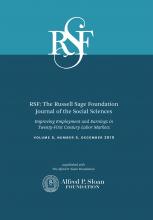Research Article
Open Access
Race in the Labor Market: The Role of Equal Employment Opportunity and Other Policies
William M. Rodgers III
RSF: The Russell Sage Foundation Journal of the Social Sciences December 2019, 5 (5) 198-220; DOI: https://doi.org/10.7758/RSF.2019.5.5.10
William M. Rodgers III
aProfessor of public policy at the Bloustein School for Planning and Public Policy, chief economist at the Heldrich Center for Workforce Development, and a nonresident fellow at the Century Foundation

REFERENCES
- ↵
- ↵
- ↵
- Ayres, Ian, and
- Peter Siegelman
- ↵
- Bayer, Patrick, and
- Kerwin Kofi Charles
- ↵
- ↵
- Bertrand, Marianne, and
- Sendhil Mullainathan
- ↵
- Blankenship, Kim M., and
- Ana Maria Del Rio Gonzalez
- ↵
- ↵
- ↵
- ↵
- Bound, John, and
- Richard B. Freeman
- ↵
- Bound, John, and
- Harry J. Holzer
- ↵
- ↵
- ↵
- Richard F. America
- Browne, Robert S
- ↵
- Card, David, and
- Alan B. Kreuger
- ↵
- Carneiro, Pedro,
- James J. Heckman, and
- Dimitry V. Masterov
- ↵
- Case, Anne, and
- Angus Deaton
- ↵
- David A. Wise
- Case, Anne, and
- Angus Deaton
- ↵
- Neil J. Smelser,
- William Julius Wilson, and
- Faith Mitchell
- Conrad, Cecilia A
- ↵
- Craemer, Thomas
- ↵
- Darity, William A., Jr.., and
- Patrick L. Mason
- ↵
- Darity, William A., Jr.., and
- Samuel L. Myers Jr.
- ↵
- Robert D. Cherry and
- William M. Rodgers
- Darity, William A., Jr.., and
- Samuel L. Myers Jr.
- ↵
- ↵
- ↵
- Esmail, A., and
- S. Everington
- ↵
- ↵
- Freeman, Richard B
- ↵
- Robert D. Cherry and
- William M. Rodgers
- Freeman, Richard B., and
- William M. Rodgers III.
- ↵
- Freeman, Richard B., and
- William M. Rodgers III.
- ↵
- Fryer, Roland G., Jr..,
- Devah Pager, and
- Jörgen L. Spenkuch
- ↵
- Gale, William G.,
- Hilary Gelfond,
- Aaron Krupkin,
- Mark J. Mazur, and
- Eric Toder
- ↵
- Harris, Fred, and
- Alan Curtis
- ↵
- Haynes, Chrysse
- ↵
- Heckman, James J
- ↵
- Holzer, Harry J., and
- David Neumark
- ↵
- ↵
- Holzer, Harry J.,
- Paul Offner, and
- Elaine Sorensen
- ↵
- Jacob, Brian A
- ↵
- ↵
- Marvin H. Kosters
- Juhn, Chinhui,
- Kevin M. Murphy, and
- Brooks Pierce
- ↵
- ↵
- ↵
- Krueger, Alan B
- ↵
- Leonard, Jonathan S
- ↵
- Leonard, Jonathan S
- ↵
- ↵
- ↵
- ↵
- ↵
- McCrate, Elaine, and
- Laura Leete
- ↵
- Miller, Conrad
- ↵
- Miller, Mark
- ↵
- ↵
- Neal, Derek A., and
- William R. Johnson
- ↵
- Neal, Derek A., and
- Armin Rick
- ↵
- Neumark, David,
- Roy J. Bank, and
- Kyle D. Van Nort
- ↵
- O’Leary, Christopher, and
- Kenneth J. Kline
- ↵
- O’Neill, June
- ↵
- ↵
- Pager, Devah
- ↵
- Pager, Devah,
- Bart Bonikowski, and
- Bruce Western
- ↵
- Reimers, Cordelia W
- ↵
- Rodgers, William M., III.
- ↵
- Rodgers, William M., III.
- ↵
- Rodgers, William M., III., and
- William E. Spriggs
- ↵
- ↵
- Rusche, Georg, and
- Otto Kirchheimer
- ↵
- Robert D. Cherry and
- William M. Rodgers
- Spriggs, Willam E., and
- Rhonda M. Williams
- ↵
- Tankersley, Jim
- ↵
- Thomas, Ward
- ↵
- Michael Fix and
- Raymond J. Struyk
- Turner, Margery Austin
- ↵
- U.S. Bureau of Labor Statistics (BLS)
- ↵
- U.S. Census Bureau
- ↵
- U.S. Department of Health and Human Services
- ↵
- U.S. Department of Justice, Office of the Inspector General
- ↵
- U.S. Department of Labor
- ↵
- Vuolo, Mike,
- Christopher Uggen, and
- Sarah Lageson
- ↵
- ↵
- Western, Bruce,
- Jeffrey R. Kling, and
- David F. Weiman
- ↵
- ↵
- ↵
- Wilson, Valerie, and
- William M. Rodgers III.
In this issue
Race in the Labor Market: The Role of Equal Employment Opportunity and Other Policies
William M. Rodgers
RSF: The Russell Sage Foundation Journal of the Social Sciences Dec 2019, 5 (5) 198-220; DOI: 10.7758/RSF.2019.5.5.10
Jump to section
Related Articles
- No related articles found.
Cited By...
- No citing articles found.









